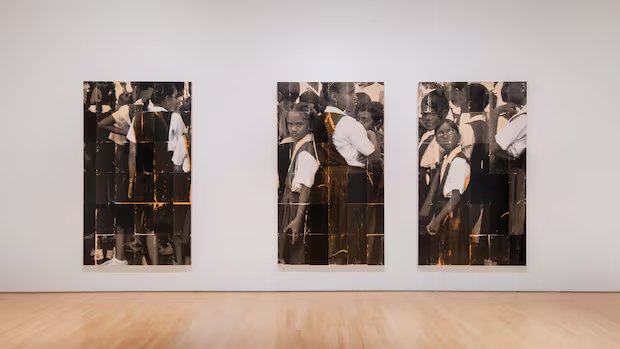In many of Sandra Brewster’s best known artworks, the image — contrary to the usual goals of photography — hasn’t been fixed in time or place by the camera.
Her portraits, featuring Black subjects, often look as if they are still in the process of developing, or as if they are weathered by time. Through these pictures that shift, fade and emerge, appearing both ancient and ongoing, Brewster attempts to visualize Black diasporic experience.
“I’m intrigued when something becomes worn,” she says, “because the wear carries histories and stories and memories — the evidence of people over a long period of time.”
The acclaimed Toronto-based artist works across drawing, painting, photo-based media, video and installation. Her artwork has been exhibited extensively, both at home and abroad, by institutions like the Power Plant Contemporary Art Gallery in Toronto, Museum of Contemporary Art Chicago and the Los Angeles County Museum of Art.
Now, Brewster is representing Ontario as a finalist for the $100,000 Sobey Art Award, the largest cash prize for contemporary artists in Canada.
To get to know the 2025 Sobey finalists, CBC Arts sent a questionnaire to each of the six shortlisted artists. Read on to learn what artist’s paintings Brewster just “couldn’t leave,” how art helps her express the ineffable and what she’s brought to Ottawa for the Sobey Art Award exhibition.
The winner of the 2025 Sobey Art Award will be announced on Nov. 8. You can follow all of our Sobey Art Award coverage here.
This interview has been edited for length and clarity.
WATCH | 2025 Sobey Art Award — Sandra Brewster:
CBC Arts: When did you first know that you wanted to be an artist?
Sandra Brewster: I’ve always been involved in the arts. I’ve always practiced in some way. I come from a family of people who naturally enjoy the arts. So, it was never a discovery of sorts, just something I was naturally attuned to. Throughout my life, I’ve worked arts adjacent while maintaining a practice no matter the circumstances. It was later that I became determined to make it my sole focus; however, it is always a precarious existence.
What does art give you the opportunity to do?
To unpack and imagine all the things I wonder about and wish for. To bring what is deep inside to the foreground.
Is there a question, inquiry or investigation central to your art practice? What is it?
In my work, I’m expressing being.
Why do you practice the disciplines you do? Why do you use the materials you do? What is their significance?
I am interested in the unfixed nature of the surfaces of my work. They appear weathered or unfinished at times. They have this nature of being in process, or as if they have existed for a long period of time.

What do you hope viewers experience through your art?
I hope they reflect on deeper understandings about each other.
To work best, what do you absolutely need?
It depends on the context of my work. Sometimes, I prefer quiet, while other times, I don’t mind the sounds of activity around me. I need space, yet occasionally what seems like a challenging environment can spark some interesting ideas and outcomes.
What was the most impactful work of art — in any medium — you experienced this past year?
In May, I was in Paris and lucky enough to see Frank Bowling’s exhibition Collage at Hauser and Wirth. I have seen his paintings before in different museums, but never as a solo exhibition. The colours and layers of paint on his large-scale works were mesmerizing and reminded me of the old-school teachings that artists should wish for viewers to keep looking. I couldn’t leave. It felt like my eyes were on a journey in, out and through his canvases. A truly wonderful experience.
If you weren’t an artist, what would you like to do for work?
I used to have an interest in studying architecture. I wish I was stronger in math. I like grids and measuring things. And travel seems to be a necessary factor. I like to travel. There is something about creating spaces for people in which to engage and having to figure all of that out which is interesting to me.

Can you tell us about the artwork you’re showing at the National Gallery of Canada for the Sobey Art Award exhibition?
I chose works that I felt were in strong conversation with each other.
Feeding Trafalgar encompasses all of it. Referencing an old photograph of my mother feeding pigeons in Trafalgar Square, it embodies movement, flight and freedom; it references history and presence as well as the impact of environment, systems and structures on our lives. The medium does the same, emphasizing the tactility and preciousness of old photographs.
I am also exhibiting Guyana Girls, a three-panel work depicting a line-up of school children in uniform. I took this photo on a reflective trip to Guyana in 2005.
Take a Little Trip is a series of layered screenshots depicting Black icons who have passed away and have influenced me — and many others — in ways of thinking and living. A video threads together separate interviews of these people, who speak on practice, family, community, culture, politics and more.
The people depicted in Take a Little Trip include musicians Minnie Riperton, Nina Simone and Salome Bey; writers Toni Morrison and Frantz Fanon; artist Jean-Michel Basquiat; performer Josephine Baker; and journalist and community activist Claudia Jones, who was founder of the Notting Hill Caribbean Carnival and Britain’s West Indian Gazette.
Long mylar works depicting the Essequibo River of Guyana hang on one wall. I use the river as a metaphor for movement from one place to another. I have grown up with stories about this river — its water brown because of the tannin from the leaves that fall into the water and the sediment and silt that sits and moves beneath.
My recently published book Blur is also in the space, sitting on a plinth. Each page depicts a work from my series Blur — “almost portraits” of people in movement. After taking these photos I transferred their image to paper, which resulted in a tactile surface referencing old photographs.
How does this artwork exemplify your practice?
My works present my thoughts and explorations on the unfixed, multi-layered existence of Black identity — a blend of time and place — without the need to be overly revealing.
The winner of the 2025 Sobey Art Award will be announced on Nov. 8 in Ottawa. The Sobey Art Award exhibition continues at the National Gallery of Canada through Feb. 8, 2026.


